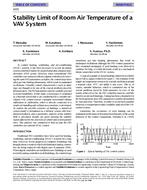
4205 — Stability Limit of Room Air Temperature of a VAV System
To control heating, ventilating, and air-conditioning (HVAC) systems, it has been necessary to accept an analog system controlled mainly by proportional-plus-integral-plus-derivative (PID) action. However, when conventional PID controllers are replaced with new digital controllers by selecting the same PID parameters as before, the control loops have often got into hunting phenomena, which result in undamped oscillations. Unstable control characteristics (such as huntings) are thought to be one of the crucial problems faced by field operators. The PID parameters must be carefully selected to avoid instabilities. In this study, a room space is simulated as a thermal system that is air-conditioned by a variable-air-volume (VAV) control system. A dynamic room model without infiltration or exfiltration, which is directly connected to a simple air-handling unit without an economizer, is developed. To explore the possible existence of huntings, a numerical system model is formulated as a bilinear system with time-delayed feedback, and a parametric analysis of the stability limit is presented. Results are given showing the stability region affected by the selection of control and system parameters. This analysis was conducted to help us tune the PID controllers for optimal HVAC control.
Units: SI
Citation: ASHRAE Transactions, 1998, Vol. 104, Part 2, Toronto, ON
Product Details
- Published:
- 1999
- Number of Pages:
- 9
- File Size:
- 1 file , 200 KB
- Product Code(s):
- D-7672


